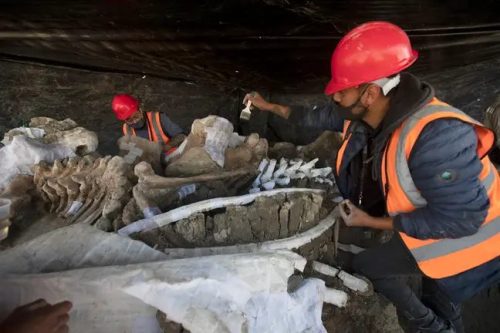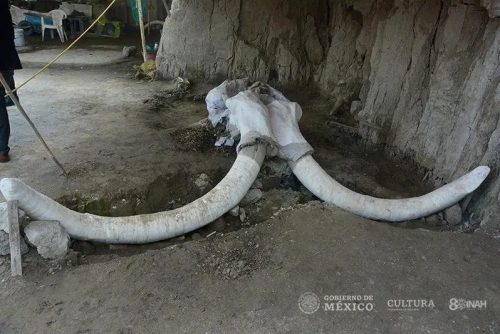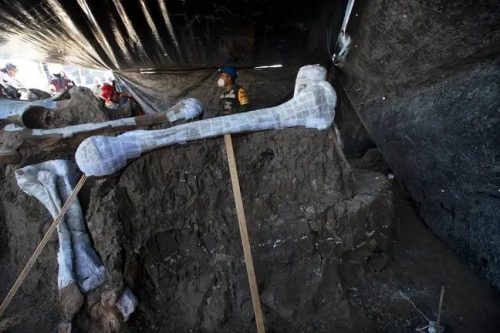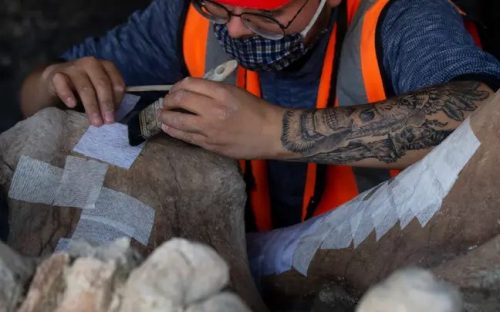
The annals of history are often etched with tales of magnificent beasts and the awe-inspiring feats of ancient civilizations. In a recent archaeological discovery, scientists have uncovered a fascinating chapter of this historical narrative – giant pits dug by prehistoric humans to trap woolly mammoths 15,000 years ago in what is now modern-day Mexico.
This remarkable find not only sheds light on the resourcefulness of early human societies but also offers a glimpse into the complex relationship between humans and these colossal creatures. In this article, we delve into the details of this discovery and its implications for our understanding of the past.
The Woolly Mammoth: A Magnificent Prehistoric Giant
Before delving into the discovery itself, it’s essential to understand the significance of woolly mammoths in the prehistoric world.
These massive creatures, known scientifically as Mammuthus primigenius, roamed the Earth during the Pleistocene epoch and were among the most iconic animals of their time. Woolly mammoths were equipped with long, shaggy hair, curved tusks, and were well-adapted to the harsh, icy landscapes of the last Ice Age.
Humans and Woolly Mammoths: A Coexistent History

The interaction between early humans and woolly mammoths is a subject of immense intrigue for archaeologists and paleontologists. These colossal creatures provided a vital source of sustenance, clothing, and shelter for our ancestors.
Hunting mammoths was no small task, and prehistoric humans had to develop innovative strategies to secure such a valuable resource. This brings us to the recent discovery in Mexico.
The Discovery
In a groundbreaking find, archaeologists working in the Tultepec region of central Mexico unearthed evidence of enormous pits dating back approximately 15,000 years.
These pits, measuring up to 25 feet deep and 82 feet in diameter, are believed to have been dug by prehistoric humans with the primary purpose of trapping woolly mammoths. The traps themselves are a testament to the ingenuity and collaboration of early human societies.

Evidence of mammoth bones and tools used by humans were discovered within these pits, further confirming their purpose. Analysis of the bones indicates that mammoths were indeed hunted and processed at these sites, providing valuable insights into the diet and survival strategies of prehistoric humans.
Implications of the Discovery
The discovery of these mammoth pits in Mexico has far-reaching implications for our understanding of prehistoric human societies. Here are some key takeaways:
Complex Societies: The sheer size and sophistication of these mammoth traps suggest that prehistoric humans were capable of organizing and executing large-scale cooperative projects. This challenges previous notions about the social structures of early human communities.
Sustainability: The ability to trap and hunt mammoths effectively points to the resourcefulness of these ancient civilizations. It highlights their capacity to adapt and thrive in challenging environments.
Human-Mammoth Interaction: This discovery offers a rare glimpse into the relationship between humans and woolly mammoths. It is a reminder that these magnificent creatures played a pivotal role in the survival and development of human societies.

Environmental Insights: The presence of mammoth remains can provide valuable data for understanding the Pleistocene environment in the region. This, in turn, can contribute to our understanding of climate change and its impact on prehistoric ecosystems.
Conclusion
The discovery of these mammoth traps in Mexico is a testament to the indomitable human spirit and the remarkable ability of early civilizations to adapt, innovate, and thrive. It provides a unique window into our shared past and a deeper appreciation for the complex relationship between humans and the awe-inspiring creatures that once roamed the Earth. As further research and excavation continue, we can only imagine what more secrets these ancient pits may reveal, offering a richer tapestry of our prehistoric heritage.






